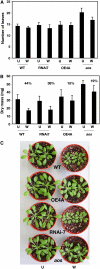A downstream mediator in the growth repression limb of the jasmonate pathway
- PMID: 17675405
- PMCID: PMC2002611
- DOI: 10.1105/tpc.107.050708
A downstream mediator in the growth repression limb of the jasmonate pathway
Abstract
Wounding plant tissues initiates large-scale changes in transcription coupled to growth arrest, allowing resource diversion for defense. These processes are mediated in large part by the potent lipid regulator jasmonic acid (JA). Genes selected from a list of wound-inducible transcripts regulated by the jasmonate pathway were overexpressed in Arabidopsis thaliana, and the transgenic plants were then assayed for sensitivity to methyl jasmonate (MeJA). When grown in the presence of MeJA, the roots of plants overexpressing a gene of unknown function were longer than those of wild-type plants. When transcript levels for this gene, which we named JASMONATE-ASSOCIATED1 (JAS1), were reduced by RNA interference, the plants showed increased sensitivity to MeJA and growth was inhibited. These gain- and loss-of-function assays suggest that this gene acts as a repressor of JA-inhibited growth. An alternative transcript from the gene encoding a second protein isoform with a longer C terminus failed to repress jasmonate sensitivity. This identified a conserved C-terminal sequence in JAS1 and related genes, all of which also contain Zim motifs and many of which are jasmonate-regulated. Both forms of JAS1 were found to localize to the nucleus in transient expression assays. Physiological tests of growth responses after wounding were consistent with the fact that JAS1 is a repressor of JA-regulated growth retardation.
Figures






Similar articles
-
Molecular reprogramming of Arabidopsis in response to perturbation of jasmonate signaling.J Proteome Res. 2014 Dec 5;13(12):5751-66. doi: 10.1021/pr500739v. Epub 2014 Oct 29. J Proteome Res. 2014. PMID: 25311705
-
The NAC-like gene ANTHER INDEHISCENCE FACTOR acts as a repressor that controls anther dehiscence by regulating genes in the jasmonate biosynthesis pathway in Arabidopsis.J Exp Bot. 2014 Feb;65(2):621-39. doi: 10.1093/jxb/ert412. Epub 2013 Dec 9. J Exp Bot. 2014. PMID: 24323506 Free PMC article.
-
Characterization of a JAZ7 activation-tagged Arabidopsis mutant with increased susceptibility to the fungal pathogen Fusarium oxysporum.J Exp Bot. 2016 Apr;67(8):2367-86. doi: 10.1093/jxb/erw040. Epub 2016 Feb 19. J Exp Bot. 2016. PMID: 26896849 Free PMC article.
-
JAZing up jasmonate signaling.Trends Plant Sci. 2008 Feb;13(2):66-71. doi: 10.1016/j.tplants.2007.11.011. Epub 2008 Feb 7. Trends Plant Sci. 2008. PMID: 18261950 Review.
-
The squeeze cell hypothesis for the activation of jasmonate synthesis in response to wounding.New Phytol. 2014 Oct;204(2):282-8. doi: 10.1111/nph.12897. New Phytol. 2014. PMID: 25453132 Review.
Cited by
-
A Genome-Wide Analysis Reveals Stress and Hormone Responsive Patterns of TIFY Family Genes in Brassica rapa.Front Plant Sci. 2016 Jun 28;7:936. doi: 10.3389/fpls.2016.00936. eCollection 2016. Front Plant Sci. 2016. PMID: 27446164 Free PMC article.
-
Overexpression of SlMYB75 enhances resistance to Botrytis cinerea and prolongs fruit storage life in tomato.Plant Cell Rep. 2021 Jan;40(1):43-58. doi: 10.1007/s00299-020-02609-w. Epub 2020 Sep 29. Plant Cell Rep. 2021. PMID: 32990799
-
Two novel RING-type ubiquitin ligases, RGLG3 and RGLG4, are essential for jasmonate-mediated responses in Arabidopsis.Plant Physiol. 2012 Oct;160(2):808-22. doi: 10.1104/pp.112.203422. Epub 2012 Aug 16. Plant Physiol. 2012. PMID: 22898498 Free PMC article.
-
Jasmonate signaling in plant development and defense response to multiple (a)biotic stresses.Plant Cell Rep. 2013 Jul;32(7):1085-98. doi: 10.1007/s00299-013-1441-2. Epub 2013 Apr 13. Plant Cell Rep. 2013. PMID: 23584548 Review.
-
Jasmonates: signal transduction components and their roles in environmental stress responses.Plant Mol Biol. 2016 Aug;91(6):673-89. doi: 10.1007/s11103-016-0480-9. Epub 2016 Apr 16. Plant Mol Biol. 2016. PMID: 27086135 Review.
References
-
- Abramoff, M.D., Magelhaes, P.J., and Ram, S.J. (2004). Image processing with ImageJ. Biophotonics Int. 11 36–42.
-
- Achard, P., Cheng, H., De Grawe, L., Decat, J., Schoutteten, H., Moritz, T., Van Der Straeten, D., Peng, J., and Harberd, N.P. (2006). Integration of plant responses to environmentally activated phytohormonal signals. Science 311 91–94. - PubMed
-
- Bonaventure, G., Gfeller, A., Proebsting, W.M., Hoerstensteiner, S., Chételat, A., Martinoia, E., and Farmer, E.E. (2007). A gain of function allele of TPC1 activates oxylipin biogenesis after leaf wounding in Arabidopsis. Plant J. 49 889–898. - PubMed
-
- Browse, J. (2005). Jasmonate: An oxylipin signal with many roles in plants. Vitam. Horm. 72 431–456. - PubMed
-
- Caldelari, D., and Farmer, E.E. (1998). Rapid assays for the coupled cell free generation of oxylipins. Phytochemistry 47 599–604.
NOTE ADDED IN PROOF
-
- Thines et al. (2007) and Chini et al. (2007) have reported finding JAZ proteins that repress jasmonate responses and are degraded in a COI1-dependent manner in jasmonate signaling. Their list includes JAS1, which, in their nomenclature, is JAZ10.
-
- Chini, A., Fonseca, S., Fernández, G., Adie, G., Chico, J.M., Lorenzo, O., García-Casado, G., López-Vidriero, I., Lozano, F.M., Ponce, M.R., Micol, J.L., and Solano, R. (July 18, 2007). The JAZ family of repressors is the missing link in jasmonate signalling. Nature http://dx.doi.org/10.1038/nature06006. - DOI - PubMed
-
- Thines, B., Katsir, L., Melotto, M., Niu, Y., Mandaokar, A., Liu, G., Nomura, K., He, S.Y., Howe, G.A., and Browse, J. (July 18, 2007). JAZ repressor proteins are targets of the SCFCOI1 complex during jasmonate signalling. Nature http://dx.doi.org/10.1038/nature05960. - DOI - PubMed
Publication types
MeSH terms
Substances
LinkOut - more resources
Full Text Sources
Other Literature Sources
Molecular Biology Databases

